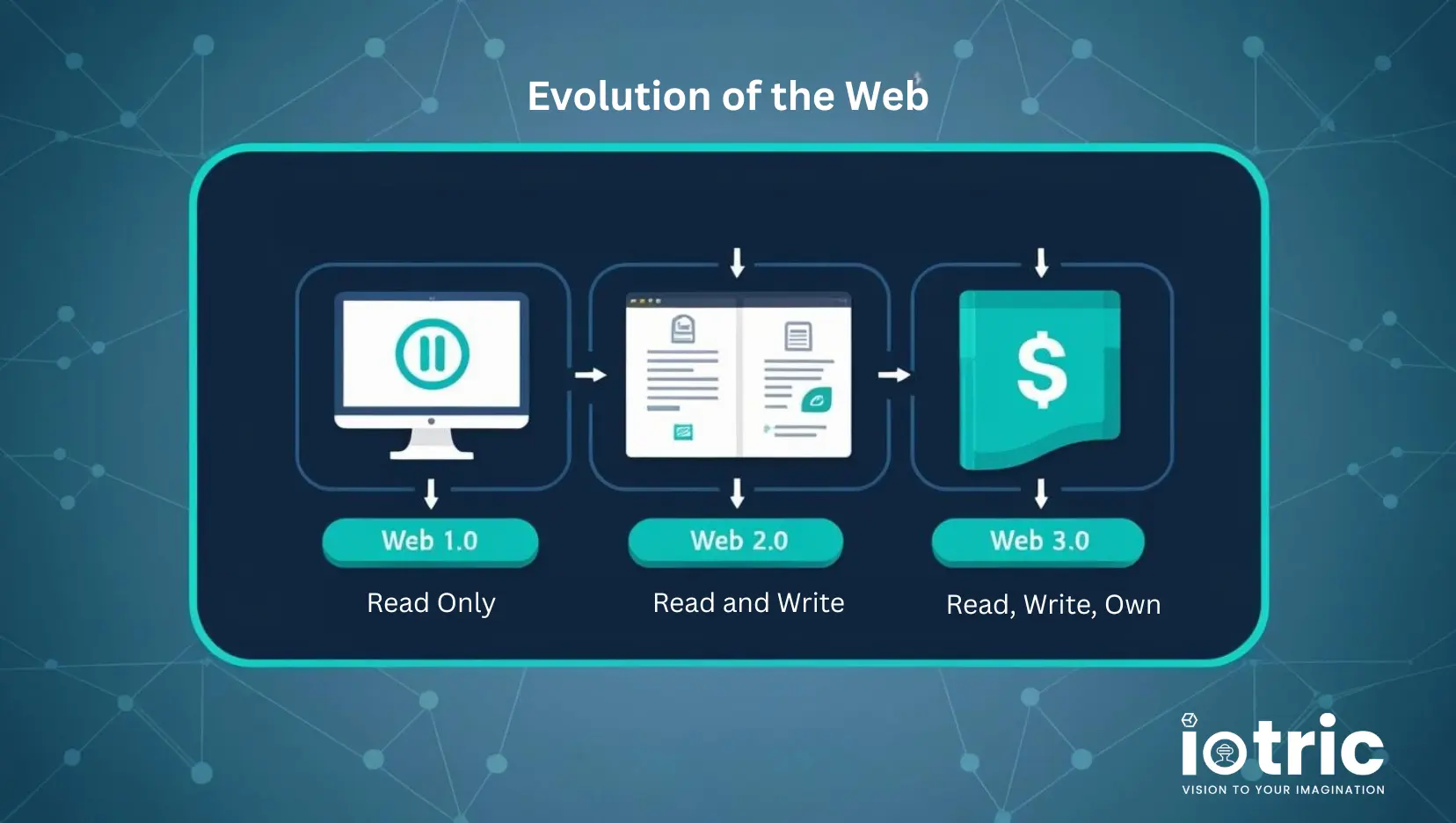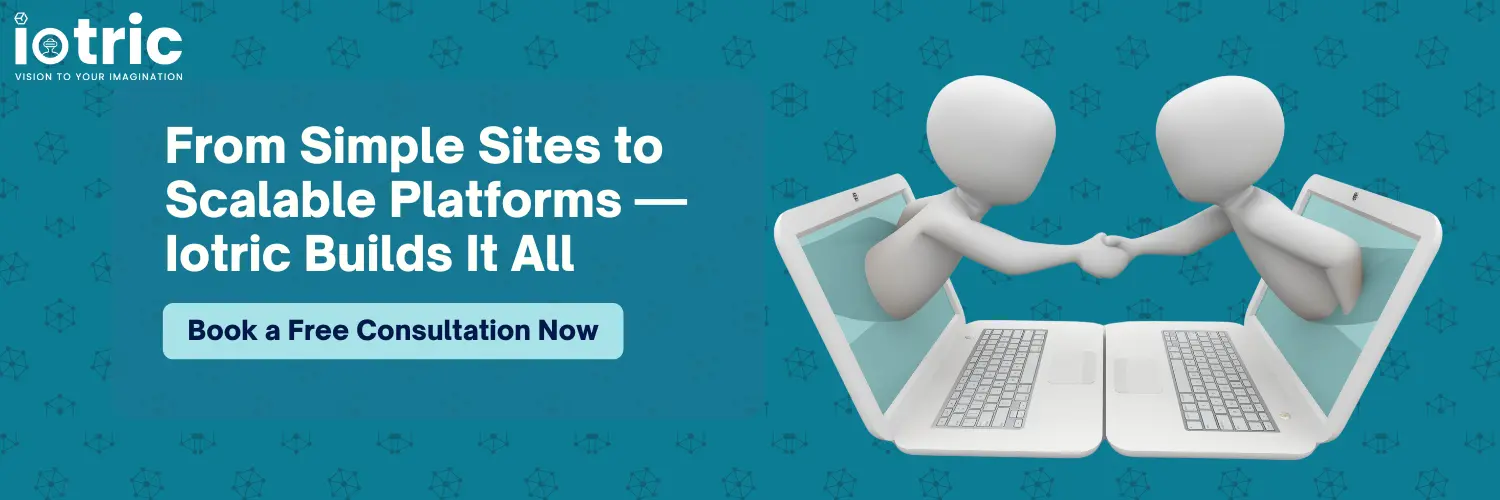The evolution of web
The evolution of Web (Web 1.0 to Web 3.0)

The internet, as we know it today, has transformed remarkably over the last few decades. What started as a static and informational resource has evolved into a dynamic, interactive, and intelligent ecosystem. This evolution of the web is described in terms of different “web generations”: Web 1.0, Web 2.0, and Web 3.0.
The evolution of the web from this basic version to what we have now has been nothing short of revolutionary. The web was primarily a one-way communication channel characterized by static websites that provided informational content with little user interaction.
Over time, the internet has evolved into an interactive space, marked by user-generated content, social media platforms, and a high degree of personalization.
In this blog, we’ll explore the three key stages of the web: Web 1.0, Web 2.0, and Web 3.0. We’ll break down what makes each one unique, the changes they’ve brought about, and how they continue to shape the digital world around us.
What is Web 1.0?
The internet, as we know it, began as a “read-only” experience, a one-way channel for delivering information to users. Websites contained only information and consisted entirely of static content. Web pages were connected by links, with nothing interactive or visually dynamic about them.
Web 1.0 refers to the earliest stage of the internet, where websites were primarily static and informational. It mostly consisted of static HTML pages hosted on web servers. These sites were designed to display content to users but allowed little interaction beyond basic navigation.
Imagine visiting a news website back in the 90s. You could read articles, check headlines, and maybe click a few links for more information. But you couldn’t leave a comment, share the article, or interact with other readers.
It was like reading a newspaper online; information was presented, but there was no platform for conversation or collaboration.
What is Web 2.0?
Most of us are familiar with the web as it exists today, commonly known as Web 2.0 or “Read-Write” web, where users are no longer just consumers; they have become creators. This shift introduced an interactive, user-driven web that powers social platforms and content-sharing applications.
Unlike the earlier static Web 1.0, Web 2.0 is all about participation and collaboration. You don’t need to be a developer to contribute; thanks to user-friendly tools, anyone can create and share content.
The success of Web 2.0 lies in its ability to empower users, providing them with the tools to shape and contribute to the web. Take Instagram or YouTube, for instance. These platforms were simple when they started. Instagram was just a photo-sharing app, and YouTube only offered a way to upload and watch videos. Over time, they evolved as users generated content, sparking more interaction and driving growth.
Initially, companies focused on attracting users, not monetizing their platforms. However, as their user base grew, they began to find ways to profit from the data they collected and the engagement their platforms generated. This focus on user data and targeted advertising became central to the business model of Web 2.0 companies like Google, Facebook, and Twitter.
However, this reliance on data comes with its own set of challenges, including frequent data breaches. Companies now monitor user data closely, often without full transparency or consent, raising concerns about privacy and control.
While Web 2.0 has revolutionized how we interact online, it has raised critical questions about data privacy, security, and control. These challenges are driving the push for Web 3.0, which seeks to decentralize the web and put more power back in the hands of users.
What is Web 3.0?
Web 3.0 represents the next evolution of the Web, shifting away from the centralized, data-driven model of Web 2.0. This new era, often referred to as the “decentralized web,” is designed to give users more control over their own data and online experiences.
Unlike Web 2.0, which relies on centralized platforms to store and manage data, Web 3.0 leverages blockchain technology and decentralized networks to create a more open, transparent, and user-centric Internet.
Web 3.0 isn’t just about browsing anymore, it gives people the power to take part in the digital world and even own a piece of it. Thanks to decentralized apps (dApps), you can use online services without needing to go through banks, big tech companies, or any middlemen.
Take cryptocurrencies like Bitcoin and Ethereum, for example. These digital currencies operate on blockchain technology, which is a core component of Web 3.0. Instead of being controlled by a central bank, transactions are verified and recorded on a decentralized ledger, ensuring transparency and security
One of the defining characteristics of Web 3.0 is its focus on decentralization. Unlike Web 2.0, where large corporations control the platforms we use, Web 3.0 seeks to distribute control across a network of users, allowing for a more democratic and open Internet.
Difference Between Web 1.0, Web 2.0, and Web 3.0
I don’t think we even need to compare all three generations, as each phase of the web evolved so clearly that the distinctions are easy to recognize.
Web 1.0 was the beginning of the Internet era. It served as a one-way street for information. Websites were static, content was fixed, and users had no way to interact or contribute.
Web 2.0 introduced participation. Users could now create, share, and engage with content. It gave rise to social media, online communities, and user-generated platforms. Interaction became the core, and people moved from being just viewers to active contributors.
Web 3.0 shifts the focus toward decentralization and ownership. Instead of relying on a few big platforms to host and control everything, Web 3.0 applications are built on blockchain and peer-to-peer networks. It’s about giving users control over their data, assets, and online identity, reducing dependence on centralized systems.
Each generation of the web reflects a clear step forward in the evolution of the web, from content publishers to users to now communities and networks.
What’s Next? The Future of the Web
As of April 2025, it’s pretty clear that we’re stepping into a new era of the internet. The web we know is changing fast. AI is no longer just a tool that follows commands; it is getting smarter, more intuitive, and honestly, more human.
At the same time, the idea of a decentralized web is gaining real momentum. People are getting tired of handing over their data to big tech. Web3 offers apps and platforms where you own your data, where there’s more transparency, and where control shifts back to the users.
What’s exciting now is how these two worlds, AI and Web3, are starting to come together. Imagine a world where AI agents run on decentralized networks, respect your privacy, and help you get things done without tracking you or selling your info.
The future of the internet is being shaped by this next evolution of the Web, an internet that’s more personal, more secure, and more empowering.
Conclusion
The web has come a long way, from static pages with plain text to dynamic platforms buzzing with user interaction, and now toward a decentralized, intelligent future. Each phase, Web 1.0, 2.0, and now 3.0, has shaped how we connect, share, and build online.
As we move deeper into 2025, it’s clear we’re not just witnessing another tech trend, we’re living through a fundamental shift in how the internet works. With AI growing smarter and Web3 gaining momentum, we’re entering a digital world that’s not only more advanced but also more human-centered.
The lines between user and creator, consumer and owner, are blurring. And the most exciting part? We’re still in the early stages. Whether you’re a developer, a creator, or just someone curious about the future of tech, now’s the time to pay attention.
